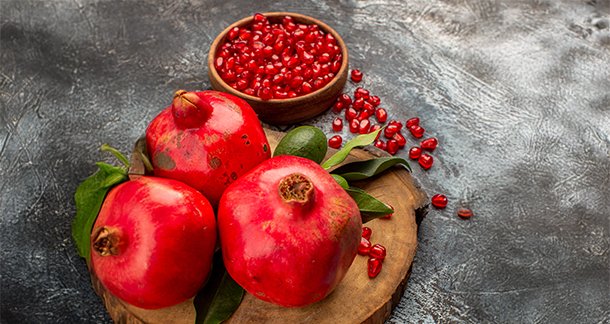Introduction
Pomegranate has been cultivated in India, South East Asia and tropical continents for thousands of years. Previously, pomegranate was not cultivated for table fruit, but rather as a beautiful plant with ornamental value, for its red, orange, or creamy yellow blooms. Pomegranates were also mentioned in ancient scriptures and used as blessings in ceremonies. Pomegranate (Punica granatum L.) is a crop from the Punicaceae family that thrives in tropical and subtropical climates. It has been cultivated by humans from ancient times. Its name derived from the Latin Malum granatum, which means “granular apple”. India is the second largest producer of pomegranate cultivation among the other developing countries. Pomegranate has a long history of utilization in traditional Chinese medicine, as well as in a variety of clinical practices among Tibetans, Uyghurs, Miaos, and other linguistic backgrounds. The global pomegranate market is segmented by product, category, application, and geography. The global pomegranate market size was worth around USD 6.18 Billion in 2024 and is predicted to grow to around USD 13.11 Billion by 2034 with a compound annual growth rate (CAGR) of roughly 7.2% between 2025 and 2034. The report analyses the global pomegranate market’s drivers, restraints/challenges, and the effect they have on the demands during the projection period. In addition, the report explores emerging opportunities in the pomegranate industry.
Structure and Nutritional Composition
Pomegranate is a balausta fruit, which is an enormous by a exocarp and mesocarp thick colored peel. The white mesocarp develops chambers (locules) that hold edible arils with seeds inside. Pomegranate juice (PJ) can be extracted from the red arils, which make up 45-52% of the overall fruit weight. The seeds account for 12-20% of the fruit and are utilized to produce seed oil, which is high in unsaturated fatty acids. Finally, the peel (40-55% of the fruit) is considered waste and is typically discarded or transported to compost or biogas producing plants. However, pomegranate peel has recently sparked interest in the extraction of bioactive components. Indeed, in recent years, many procedures have been established to use pomegranate peel or seeds and extract their active components.
Pomegranate Processing
Improper harvesting and handling during transport often cause bruising and cracking, leading to microbial invasion and decay. Storage at suboptimal temperatures can induce chilling injury symptoms such as husk scald, pitting, and surface browning. High water loss during storage and marketing results in shriveling, weight reduction, and poor consumer acceptance.
Washing helps to minimize pesticide residues on the surface of fruits. The purpose of washing is to investigate the effectiveness of various non-toxic washing agents. Pesticide residue levels steadily decreased throughout washing processes. Sorting and grading pomegranates into distinct quality categories enables producers to adjust marketing and packaging methods to specific customer segments. This method comprises categorizing pomegranates based on size, maturity, and quality. Mechanical, steam, chemical, and hand peeling are the most popular peeling methods. Processing enhances both the economic and nutritional value of pomegranates. By converting fresh fruit into juice, concentrates, arils, powders, and extracts, the industry extends shelf life and creates new market opportunities. Efficient processing, including thorough cleaning, de-seeding, juicing, and preservation, ensures product quality, safety, and consumer satisfaction.
Table 1: POST HARVEST TREATMENTS
|
|
Key Effect |
|
Pre-conditioning |
Reduces chilling injury during storage |
|
Intermittent warming |
Prevents fungi at 0°C but increases chilling injury risk |
|
Controlled atmosphere |
Slows respiration, delays senescence, reduces fungal growth |
|
Modified atmosphere |
Extends shelf life, reduces water loss |
|
Polyamines (PAs) |
Reduce chilling injury, minimize weight loss |
|
Oxalic acid (OA) |
Reduces chilling injury, boosts antioxidants, maintains quality |
|
Gamma irradiation |
Up to 1 kGy safe; effective for disinfestation but lowers anthocyanins |

Post-Harvest Challenges
Pomegranates are highly perishable fruits, and significant post-harvest losses occur due to mechanical damage, microbial spoilage, and physiological disorders. Improper handling during harvesting and transportation leads to bruising and cracking of fruits, making them more susceptible to decay. Chilling injury (pitting, husk scald) develops during cold storage at low temperatures, reducing fruit quality. High water loss during storage and marketing results in shriveling, weight loss, and reduced consumer appeal.
Utilization of Pomegranate Waste
Waste from pomegranates, which primarily consists of peels, seeds, and pomace, can be utilized effectively for producing products with more economic value. Bioactive substances found in the peel, including as polyphenols and tannins, are utilized in natural preservatives, cosmetics, functional meals, and nutraceuticals. Seeds serve as a source of edible oil rich in punicic acid, with applications in dietary supplements, skincare, and even biodiesel production. By-products of pomace and juice can be utilized as natural colorants, vinegar, compost, animal feed, and drinks. Thus, pomegranate waste offers significant potential for sustainable utilization and value addition instead of disposal.
Conclusion
Pomegranate processing is essential for increasing the fruit’s economic and nutritional worth. By converting fresh pomegranates into juice, concentrates, arils, powders, and extracts, the processing business not only increases the fruit’s shelf life but also creates new market prospects. Efficient processing processes, such as thorough cleaning, de-seeding, juicing, and preservation, product quality, safety, and consumer satisfaction. Furthermore, advances in processing technology and by-product usage, such as antioxidant extraction from peels and seeds, help to promote sustainability and reduce waste. To summarize, pomegranate processing is an important part of the agro-industry, increasing the fruit’s usability, market reach, and economic value.
About Author
Karthika. R1, Dr. Dakshayani.R2, Dr.R. Jagan Mohan3
1M. Tech Student, 2 Senior Research Fellow, *3 Dean (Student Welfare),
National Institute of Food Technology, Entrepreneurship and Management, Thanjavur.



